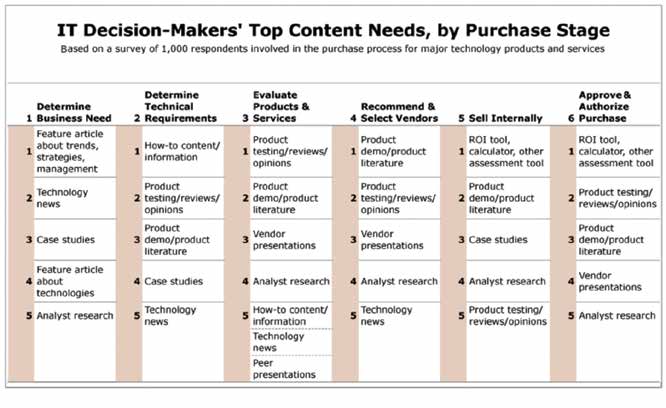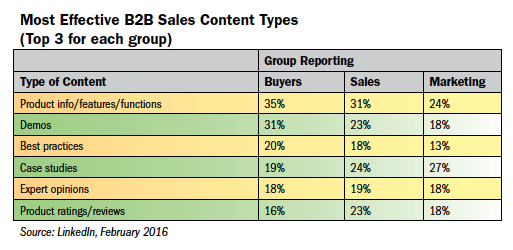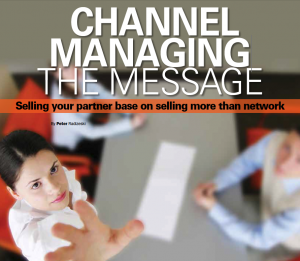Channel Managing the Message
Selling your partner base on selling more than network
By: Peter Radizeski

How do you convince your channel partners to sell beyond network? That seems to be the biggest problem after getting partners to sell your network.
On a recent webinar, the carrier channel manager rambled on about the entire catalog of services. There are two hitches with that approach. One, he was not treating the listeners’ attention like the gold that it is. You want the channel partner to hear you and realize you have something valuable for them, but he discounted the expense of the Attention. Two, he didn’t properly prepare and forgot to include WIIFM.
In today’s world the most valuable item is Attention – or put another way: Time.
There are so many hurdles to a webinar. First is getting the potential attendee to read the invite; then to register; then to add it to her calendar as an appointment. The big step is getting the attendee to actual dial-in. After that, it is up to the presenter to capture the attendee, prove the value of the webinar and try to get the attendee to take action.
All of that goes up in smoke when the presenter sucks. After having attended numerous conferences and webinars and moderated many panels, I’ve come to realize that speakers are a lot like politicians; they have talking points to get out whether it fits or not. That makes for an awful presentation.
I watched a senior vice president at Cisco years ago show videos during his keynote when he wasn’t reading the slides to the audience. Is that how he presents to the Board or his CEO? Of course not. He would get fired. How is that audience any different than a conference audience?
Attendees have paid to be there. They are giving up their time to listen. And the presenter chooses to cheapen it by not preparing and giving an ordinary talk.
This brings us to the second hitch: Getting the attendee to hear and take action. Humans like stories. It is how we relate and how we learn. It is why case studies are popular.
I understand that you want to show off your company, but you need to frame it in a way that says, “What’s in it for the listener?” Would you have coffee with a friend and give the same presentation? Then why do it to a stranger?
 Today, with the number of conferences, road shows and webinars increasing, there is more opportunity to get in front of potential partners. This is a chance to make that first impression. Are you going to do that by puking on them about the company fact sheet? I hope not.
Today, with the number of conferences, road shows and webinars increasing, there is more opportunity to get in front of potential partners. This is a chance to make that first impression. Are you going to do that by puking on them about the company fact sheet? I hope not.
There are a number of ways to personalize it. One way is to start with what you like best about the company or why you joined the company (other than I needed a paycheck). Maybe the company culture is better than most providers or the uptime is higher. What is the value prop?
RELATED: In the Trenches: Attention and Demand
Another way is to just talk about the last deal. Or talk about an upsell: “A partner brought in a client to buy network and after discussion we found that the client was also worried about security so we bundled managed security with the WAN.”
These will be required to sell SD-WAN. It will be use cases over and over to get the word out about how SD-WAN is being deployed for the customers and implemented by the provider.
Remember: the channel manager is the conduit to the company. The channel is about relationships. Everyone who has been in the channel more than five years understands that. It is about relationships because telecom is messy and trust is hard to establish.
This doesn’t preclude the need to tell a compelling story.
Telecom is a me-too business. Thousands of hosted VoIP and UCaaS providers have a problem with both differentiation and positioning (where they fit best in the marketplace). Competition in the UC space from Microsoft and Cisco is strengthened by their strong brand and their certified ambassadors making the purchasing decision. In addition, the softswitch vendors – Metaswitch, GenBand Broadsoft – are now selling direct on top of white-label options that are just adding to the muddy waters. How do you break through that noise?

Leverage the advantages that you have. These include your current relationship with the partner, the deployment process that the partner is already experienced with and the uniqueness of your company. Listening to customers will give you content to discuss. Why did the customer pick you? What was the pain point or hot button? Was it mobility, portal, user management, analytics or something else that was the tipping point? This is what the presentation should contain.
If your UCaaS is based on Broadsoft, how are you different than the other 300-plus? You better make that crystal clear – or we go to a price war.
RELATED: ChannelVision Report: 9 to Anytime
Think about how you buy a smartphone, a business tool that you will look at 2,000 times per day for two years. The look and feel of the device is as much a part of the story as the choice of operating system is. Can you see how relevant that process might be to your services?
If you can’t tell a story that will resonate with the partner, you better start talking about the price and the spiff then!
A spiff war already is happening. Partners are being bombarded by spiff. Some of it is to capture attention. Some of it is to buy market share.
Carriers would be wise to use spiffs to get partners to take notice of other types of services such as Office 365, conferencing or backup. These services are different to sell than bandwidth, but they are stickier and can lead to the sale of other services. They also allow the partner to have a diverse conversation with the prospective customer. It is a good time to take advantage of all the noise and hype around Microsoft. Leverage that brand and press to get meetings, get a small sale, and prove yourself.
 Understandably, getting partners to sell services such as hosted email, cloud, conferencing, backup and SaaS is the struggle. Chief reason is that they are heads done just trying to sell enough to stay afloat. Price compression on DIA, T1, broadband and voice means that you have to sell two or three times as many deals to make the same as you did a few years ago.
Understandably, getting partners to sell services such as hosted email, cloud, conferencing, backup and SaaS is the struggle. Chief reason is that they are heads done just trying to sell enough to stay afloat. Price compression on DIA, T1, broadband and voice means that you have to sell two or three times as many deals to make the same as you did a few years ago.
That is exactly why when you have their attention at the next conference or webinar that you cannot give the same spiel that you have been using during your entire career in telecom. You want change? Then your spiel has to change. Start telling stories about successes, deals, business outcomes and hot buttons – even ways to newsjack.
We live in a social media world with sound bites. You have to adjust for that. Choose words carefully. Be impactful. Be visual. Be emotive.
This sounds like a lot. It is, and it isn’t. If you aren’t preparing for presentations then it is a lot of extra work (over winging it). If you are preparing, it is the same amount of time used in a different manner.
Many blogs today use tweet-able phrases with a link to tweet this now. Every presentation has one goal. What is that? The entire presentation should be that one concise goal. That goal should be about 140 characters. The stories should underscore that goal.
“The key in mastering any kind of sales is switching statements about you and how great you are and what you do, to statements about them, and how great they are and how they will produce more and profit more from ownership of your product or service,” advises business trainer, speaker and author, Jeffrey Gitomer.
“If leaders are to be followed,” he says, “it starts with clarity of message.”
Peter Radizeski, president of RAD-INFO INC, started as a VAR, then became an agent. Now he writes about the channel and the telecom space while consulting to service providers and occasionally still selling some circuits.
VIEW ARTICLE
SUBSCRIBE TO MAGAZINE
About ChannelVision Magazine:
ChannelVision is a bi-monthly digital and print magazine, read by channel partners selling all manner of voice, data, access, managed and business services (both on premise and “in the cloud”), as well as, technology, gear, and equipment. ChannelVision is a highly focused and efficient way for service providers, hardware, and software companies to reach experienced channel partners targeting the small/medium business space. Serving a controlled circulation of providers and indirect distributors of communications, network, IT and cloud-based business services, ChannelVision is telecom’s gateway to perspective on how to adapt, what to sell, and how to sell it.










